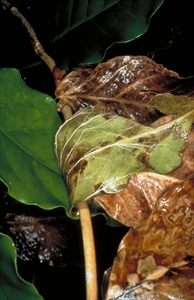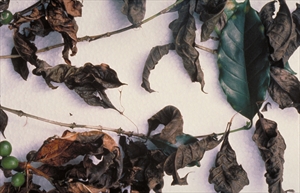Thread blight, koleroga disease, black rot.
Pacific Pests, Pathogens, Weeds & Pesticides - Online edition
Pacific Pests, Pathogens, Weeds & Pesticides
Coffee thread blight (199)
Pellicularia koleroga. The fungus is also known as Corticium koleroga, which is the name of the sexual state of the fungus. The name Pellicularia koleroga probably includes a number of species.
Asia, Africa (restricted), North, South and Central America, the Caribbean, Europe (restricted), Oceania. It is recorded from American Samoa, Federated States of Micronesia, Fiji, New Caledonia, Papua New Guinea, Samoa, and Vanuatu.
Coffee (Coffea arabica and Coffea canephora), black pepper, capsicum, citrus, ginger, mahogany, tea.
The fungus forms mats and threads of light-coloured growth on the underside of leaves and twigs (Photo 1). At first, the leaves appear light grey and dry. Later, the leaves blacken and fall. In severe cases the dead leaves become detached from the branches but are held in places by the threads of the fungus (Photo 2). Dieback may follow the fall of the leaves.
An important and destructive disease of many hosts in wet tropical countries. There are no reports of the extent of the damage.
Look for the white threads of the fungus forming webs over the underside of leaves, and causing leaf fall. Look for the black threads of the fungus that often hold the leaves in place. Compare with other thread blights, e.g., white thread blight, Marasmiellus (Marasmius) scandens (see Fact Sheet no. 15), and horse hair blight, Marasmius crinis-equi (see Fact Sheet no. 05).
CULTURAL CONTROL
- Prune branches 30 cm below the affected part. Remove the prunings from the plantation and burn them.
- Reduce shade levels; consult agricultural authorities for information on the density of shade trees required.
CHEMICAL CONTROL
It is unlikely that this disease is of such economic importance that chemical control would be needed. If it were, use a copper spray.
____________________
When using a pesticide, always wear protective clothing and follow the instructions on the product label, such as dosage, timing of application, and pre-harvest interval. Recommendations will vary with the crop and system of cultivation. Expert advice on the most appropriate pesticides to use should always be sought from local agricultural authorities.
AUTHOR Grahame Jackson
Photos 1&2 Kohler F, et al. (1997) Diseases of cultivated crops in Pacific Island countries. South Pacific Commission. Pirie Printers Pty Limited, Canberra, Australia.
Produced with support from the Australian Centre for International Agricultural Research under project PC/2010/090: Strengthening integrated crop management research in the Pacific Islands in support of sustainable intensification of high-value crop production, implemented by the University of Queensland and the Secretariat of the Pacific Community.





